The Mumbai neighborhood made famous by the film Slumdog Millionaire is set to host its first biennale, aiming to promote health through creativity, although it is set to be very different to some of the world’s grander art fairs.
The three-week festival, scheduled to open today, is set to showcase works created by residents of Dharavi, the densely populated settlement in the heart of India’s financial capital.
From hand-painted pots arranged to show how sexually transmitted diseases are spread, to a quilted map marking known locations of domestic violence, the Dharavi Biennale is designed to raise awareness without being “preachy,” the organizers said.
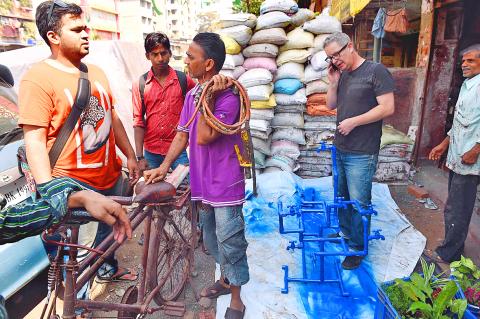
Photo: AFP
However, they also want to celebrate the neighborhood itself, home to an estimated 750,000 people from all over India, which has been held up over the years as a symbol of both grimy destitution and flourishing industry.
“What we see is that Dharavi is sitting on a lot of wealth and a lot of talent and art that gets missed out when you want to show squalor and slum,” festival co-director Nayreen Daruwalla said.
Britain’s Prince Charles in 2010 cited Dharavi as a role model for sustainable living, praising its habit of recycling waste and the “order and harmony” of the community, in contrast with Western countries’ “fragmented” housing estates.
However, the difficulties facing the community remain stark, and “there is a danger of going to the other side and romanticising,” said Daruwalla, citing the cramped conditions, poor ventilation and lack of toilets.
With such issues in mind, Mumbai-based non governmental organization the Society for Nutrition, Education and Health Action held the Dekha Undekha, or Seen Unseen, exhibition in Dharavi two years ago, aiming to foster discussion through art about themes such as sanitation and maternal health.
Its success led the organization to develop the the Dharavi Biennale, a more ambitious project funded by the British charity the Wellcome Trust, which culminates in the exhibitions and events this month at various locations across Dharavi’s maze of alleyways.
Aside from being held every two years, the festival has little in common with some of the world’s better known art fairs, festival co-director David Osrin said, adding during a presentation this month that the name is “slightly a joke, and slightly ideological.”
“The spirit and the way that our biennale is structured is very, very different,” he told reporters.
While other festivals simply ask artists to submit works, the focus in Mumbai has been on participation with Dharavi residents, particularly through workshops led by “mentor” artists.
The results include the Immunity Wall, a depiction of the body’s immune system using recycled materials and everyday items: red hair bobbles for red cells, scouring pads for B cells and flexi bracelets as antibodies.
Another exhibit uses traditional block-prints on cloth to illustrate the various levels of depression, a problem thought to be widespread but under-diagnosed in Mumbai’s shantytowns.
Thousands are expected to attend the exhibitions over the coming weeks and social scientists plan to conduct surveys to try and assess the festival’s impact.
“It’s quite an ambitious thing to try to develop artworks that speak to a health agenda without being preachy, and we think we’ve achieved it, but it would be very interesting to know what people actually think about that synthesis,” Osrin said.
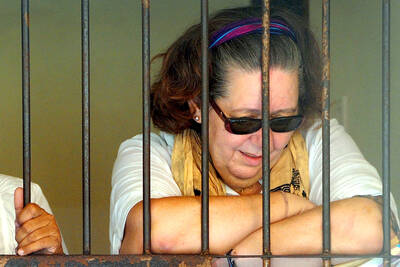
Indonesia was to sign an agreement to repatriate two British nationals, including a grandmother languishing on death row for drug-related crimes, an Indonesian government source said yesterday. “The practical arrangement will be signed today. The transfer will be done immediately after the technical side of the transfer is agreed,” the source said, identifying Lindsay Sandiford and 35-year-old Shahab Shahabadi as the people being transferred. Sandiford, a grandmother, was sentenced to death on the island of Bali in 2013 after she was convicted of trafficking drugs. Customs officers found cocaine worth an estimated US$2.14 million hidden in a false bottom in Sandiford’s suitcase when
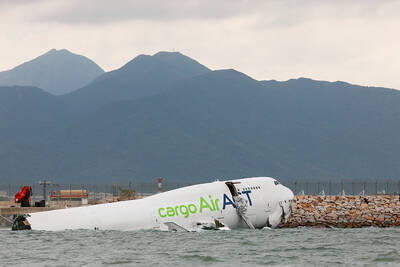
CAUSE UNKNOWN: Weather and runway conditions were suitable for flight operations at the time of the accident, and no distress signal was sent, authorities said A cargo aircraft skidded off the runway into the sea at Hong Kong International Airport early yesterday, killing two ground crew in a patrol car, in one of the worst accidents in the airport’s 27-year history. The incident occurred at about 3:50am, when the plane is suspected to have lost control upon landing, veering off the runway and crashing through a fence, the Airport Authority Hong Kong said. The jet hit a security patrol car on the perimeter road outside the runway zone, which then fell into the water, it said in a statement. The four crew members on the plane, which
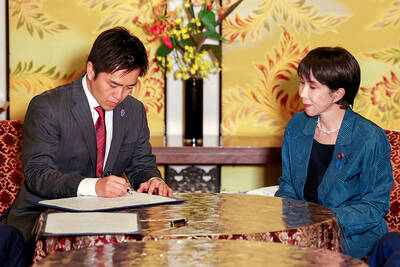
Japan’s ruling Liberal Democratic Party (LDP) and its junior partner yesterday signed a coalition deal, paving the way for Sanae Takaichi to become the nation’s first female prime minister. The 11th-hour agreement with the Japan Innovation Party (JIP) came just a day before the lower house was due to vote on Takaichi’s appointment as the fifth prime minister in as many years. If she wins, she will take office the same day. “I’m very much looking forward to working with you on efforts to make Japan’s economy stronger, and to reshape Japan as a country that can be responsible for future generations,”
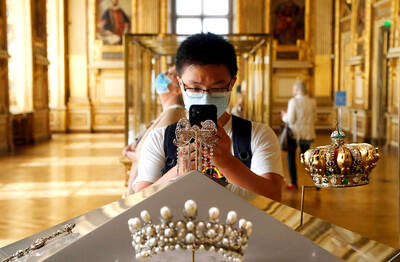
SEVEN-MINUTE HEIST: The masked thieves stole nine pieces of 19th-century jewelry, including a crown, which they dropped and damaged as they made their escape The hunt was on yesterday for the band of thieves who stole eight priceless royal pieces of jewelry from the Louvre Museum in the heart of Paris in broad daylight. Officials said a team of 60 investigators was working on the theory that the raid was planned and executed by an organized crime group. The heist reignited a row over a lack of security in France’s museums, with French Minister of Justice yesterday admitting to security flaws in protecting the Louvre. “What is certain is that we have failed, since people were able to park a furniture hoist in the middle of